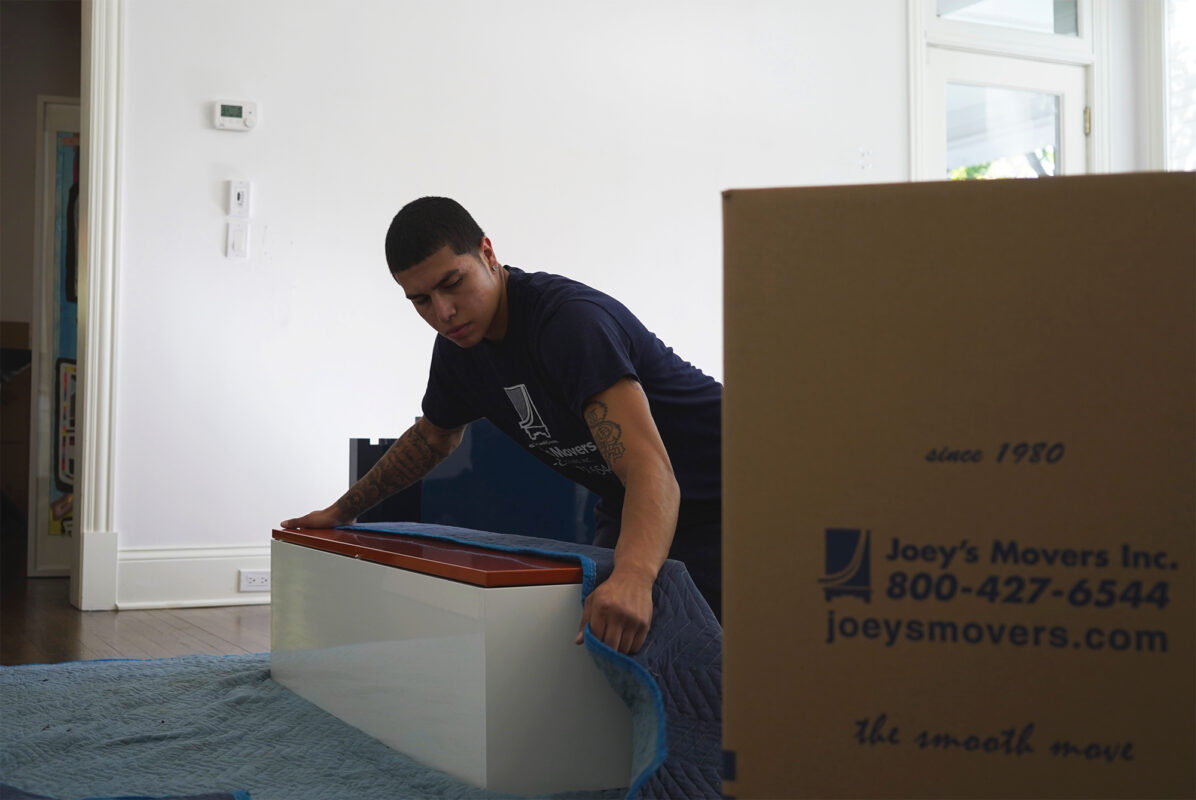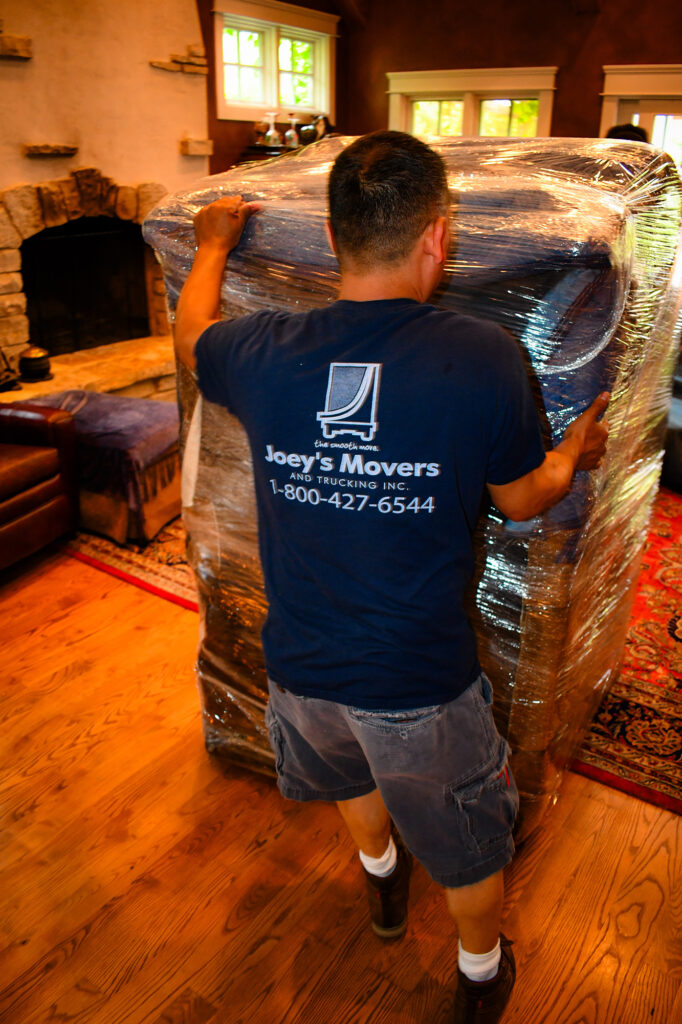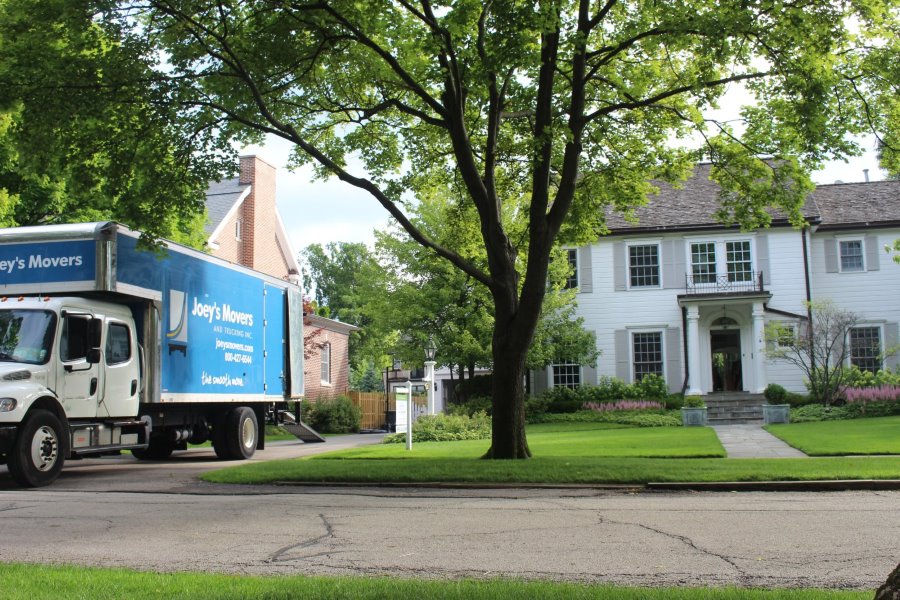Memories aren’t the only thing that moving leaves behind; it can also leave behind costly floor damage. Your flooring is one of the most vulnerable parts of your home, so protecting your floors is essential. That’s why protecting floors when moving should be part of your overall moving plan—not just an afterthought.
In this guide, we’ll walk you through how to protect your floors during a move. We’ll cover the best materials, techniques, and our own best professional moving strategies to prevent scratches, dents, and other damage.
Alternatively, hire professional movers who will use extreme care when moving your items, mitigating damage to your floors. Hire Joey’s Movers. Call us today at (847) 674-7779, or get a free online quote.
Floor Protection Matters When You’re Moving
Failing to protect floors during a move can lead to unsightly damage and costly repairs. Hardwood refinishing ranges from $400 to $1,500, replacing vinyl planks in an entire room can exceed $2,000, and tile repairs cost between $300 and $800 per section.
Floors often get damaged in three main ways:
- Dragging heavy furniture can cause deep scratches or gouges.
- Dirt and debris buildup from shoes and moving equipment can grind into surfaces, leaving permanent marks.
- Dropping heavy items may crack tile or dent hardwood, leading to expensive fixes.
Taking preventive measures, like using furniture sliders, protective mats, and shoe covers, can help avoid unnecessary damage and expenses.
How to Protect Different Types of Flooring During a Move
Different floors have different risks and vulnerabilities, so protecting them starts with knowing what each type needs. The right materials and techniques can prevent damage and save on repairs. Here’s how to safeguard hardwood, vinyl, tile, and carpet like a pro!
Hardwood Floors: Preventing Scratches and Dents
Hardwood floors add beauty to a home, but they’re also highly vulnerable during a move. A single careless drag of a couch leg or a box resting on debris can leave a lasting scratch or gouge, leading to costly repairs. Protecting them properly can save you from unnecessary damage and stress.
- Cover Large Areas With Rosin Paper or Ram Board. Rosin paper is also known as building paper or slip-sheet paper. It is a lightweight felt paper used in construction to create a friction and moisture barrier. Professional movers and construction workers use it to shield large floor spaces from scratches and foot traffic.
Ram board is a thicker, heavy-duty roll of recycled fibers that allows for more robust protection than rosin paper. It protects against impacts, stains, scratches, mud, and more.
- Furniture Sliders and Felt Pads. You can use furniture sliders or felt pads under heavy furniture to reduce friction and prevent gouges. This can also help you move these objects more easily across various surfaces!
- Avoid Dragging. Try to lift and carry furniture when you can to avoid contact with the floor entirely. When items are too heavy to be lifted, use furniture-lifting straps or a dolly with soft rubber wheels to prevent marks or dents!
Vinyl and Laminate Flooring: Protecting Against Tears and Indentations
Vinyl and laminate flooring can easily tear or dent, especially under the weight of heavy furniture and appliances with sharp edges. Protecting these surfaces requires proper cushioning and weight distribution.
- Moving Blankets and Area Rugs. Moving blankets are specifically designed for impact protection and are widely available with moving supplies. Placing thick blankets or rugs under furniture and appliances adds a protective layer, reducing the risk of dents and scratches.
- Plywood Sheets and Appliance Mats. For extra protection, use ¼” to ½” plywood sheets or ram board to distribute weight evenly and prevent pressure dents. Appliance mats also add a layer of protection under heavy washers, dryers, and refrigerators.
- Avoid Dragging Heavy Items. Dragging can cause tears and permanent scuffs. Use a dolly or carry items with furniture lifters whenever possible to prevent unnecessary damage.
Tile Floors: Avoiding Cracks and Chips
Tile generally holds up extremely well under daily use, but it’s vulnerable to cracking and chipping from impact or weight concentrated into a small area.
- Cardboard Sheets, Ram Board, and Plywood. These materials create a barrier against hard impacts, redistribute weight, and avoid damage from dragging heavy items. Cardboard sheets can be repurposed from large moving boxes or bought from moving supply stores. Ram board and plywood provide stronger protection against heavy impacts and spills.
- Rubber Wheels. Dollies and carts with rubber wheels are gentler on floors than those with metal or hard plastic casters. If you’re renting, try to ask specifically for non-marking or rubber wheel options.
- Drop Cloths and Moving Blankets. To protect against accidental drops, thick canvas or plastic sheets can be tucked around work areas. These sheets help furniture slide across surfaces without damaging the floor.
Carpet: Preventing Stains and Wear
Carpet looks lovely, but it is very vulnerable to stains, rips, and permanent wear from heavy furniture, muddy shoes, or moving equipment.
- Plastic Film Carpet Covers. Carpet protectors cling to the carpet and create waterproof, non-slip barriers. They are ideal for creating usable paths across high-traffic areas.
- Masonite Sheets. Masonite can help protect carpet fibers from being ripped, soiled, crushed, or torn up by dolly wheels.
- Furniture Foot Covers. Covering furniture feet with moving cloths, sliders, or plastic wrap will help keep carpets clean and avoid snagging.
What Do Professional Movers Use to Protect Floors?
Floor protection isn’t just about preventing damage—it’s about working efficiently and minimizing risks. Here are ways that our professional movers safeguard your floors.
Rosin Paper vs. Ram Board: Which One Should You Use?
Rosin Paper and Ram board are both solid choices for protecting your floor. The one you should use on each floor depends on how heavily the area will be used.
- Rosin Paper is lightweight and flexible. It should be used primarily for short-term protection or low-traffic areas that won’t constantly have people in and out. It’s cost-effective for protecting lightly used walkways during packing or if there is no risk of damaging the floor with impact from heavy items.
- Professionals use ram boards (or heavy-duty fiberboard) to protect high-traffic areas or places where heavy items will pass through. It is durable, spill-resistant, and thick, so it can handle foot traffic, spills, impacts from dropping, and more.
Furniture Sliders Prevent Scratches and Dents
Furniture sliders are placed under heavy items like couches, dressers, and tables to allow them to glide smoothly across the floor. Sliders minimize friction and reduce the risk of deep scratches, scuffs, or pressure dents. They are especially useful for hardwood, vinyl, and laminate flooring.
Dollies with Rubber Wheels Are A Safer Way to Move Heavy Items
Metal or hard plastic wheels on furniture and dollies can leave dents, scratches, or even gouges in the floors. Professional movers use dollies with rubber wheels because they provide better grip and cushioning to prevent damage. These wheels distribute weight more evenly and reduce impact on sensitive flooring materials.
Moving Blankets and Pads Protect Against Sharp Corners and Drops
Moving blankets and padding protect furniture from scratches and keep floors safe. Thick, cushioned blankets also absorb the impact when a heavy item drops to the ground, preventing costly dents, cracks, and scuffs.
Doorway Ramps and Threshold Covers Prevent Damage at Entry Points
Doorways and thresholds are among the most vulnerable areas during a move because they frequently come into contact with heavy furniture, appliances, and moving equipment. Tight entryways make it easy for furniture legs, corners, or metal edges to scrape against the flooring as movers navigate through narrow spaces.
Thresholds are particularly at risk. When a heavy load rolls over a raised threshold, the weight and pressure can create dents, cracks, or loosen tiles. Uneven surfaces also increase the chances of items tipping over and falling to the floor.
- Doorway Ramps create a smooth transition between spaces and make it easier to roll items in and out without an issue.
- Threshold Covers absorb pressure and prevent cracks or chips when heavy objects pass over them.
Professional movers utilize all these tools to keep your floors and your belongings safe. Investing in proper floor protection can save time, money, and stress in the long run.
How to Protect Floors While Moving Furniture
A single mistake with heavy or bulky furniture can scratch, tear, crush, or crack your flooring—which is why it’s critical to understand how to protect floors when moving furniture. However, with the right techniques and tools, you can move heavy pieces safely without leaving a mark.
Here’s a step-by-step guide to protect your floors while moving furniture.:
- Place Protection. Before moving anything, start by preparing the base of your furniture. Use sliders or moving blankets under each leg or corner. Felt or rubber-bottom sliders work best on hard and smooth surfaces, and plastic sliders are better for carpeted floors.
- Lift, Don’t Drag. Dragging furniture is the quickest way to damage your floor. Lift the furniture or use floor protection to glide it along instead. Use a furniture-lifting strap for heavy or awkward items or enlist help. This will reduce the risk of tipping or dropping the furniture.
- Use a Dolly. If you have a dolly, load your furniture onto it to ensure the weight is centered and balanced. Dollies with rubber wheels allow you to roll heavy items smoothly without causing damage. If needed, secure the furniture with straps or bungee cords to keep it steady during the move, and utilize threshold covers and ramps as needed.
- Set It Down Gently. When placing the furniture, resist the urge to slide it into position. Shoving or sliding it off the dolly can leave scuff marks and pressure dents, so take the time to lower it carefully where you want it.
- Remove Protection and Check for Debris. Once everything is in place in your new home, remove the protection from the furniture. Double-check the area to ensure no grit or debris got trapped underneath, as this can cause scratches or other damage if the furniture shifts.
Taking a few extra minutes to move furniture carefully can save you a lot of repairs and help preserve your floors.
How to Protect Vinyl Flooring When Moving Appliances
Vinyl is soft, flexible, and prone to tearing, denting, and scratching under concentrated weight or sharp edges. You will need floor protection for moving appliances like refrigerators, washers, and dryers.
- Place thick moving blankets under appliances. These act as cushions and barriers between the appliance and the floor.
- Place appliance mats, ram boards, or ¼” plywood sheets to create protected pathways and barriers. This reduces friction and adds an extra layer of protection between the appliance and the floor.
- Avoid Rolling Directly on Vinyl. Even if your appliances have wheels, try to avoid rolling them directly on vinyl flooring. These small plastic or metal wheels can concentrate the weight and pressure onto the floor, and this will leave permanent tracks or indentations. Create protected pathways, use a dolly with rubber wheels, or carry them instead.
These simple precautions will help you safely move appliances without risking damage to your vinyl flooring.
DIY vs. Professionals: When to Hire Movers
Deciding between DIY protection and hiring professional movers depends on several factors, including the size of your move, the value of your flooring, and the type of furniture you’re moving. If you’re prioritizing protecting floors when moving, both the materials you use and the techniques you follow can have a big impact. Here’s a breakdown to help you make the best choice for your situation.
When DIY Floor Protection Is Enough
DIY floor protection works well for smaller moves or when you’re only moving light furniture. Protection like felt sliders, threshold protection, and plywood sheets are typically sufficient to prevent damage.
DIY methods are also suitable if you’re moving on a budget or want more control over the process. However, this method can be time-consuming and labor-intensive.
When Professional Movers Are Worth It
Professional movers have the experience and equipment to ensure your floors stay protected during the entire process. They’ll use high-quality materials like ram board, moving blankets, ramps, and threshold protectors specifically designed for your type of flooring. You may want to consider their services if:
- You have a lot of bulky and heavy furniture and appliances
- It is difficult to lift and carry furniture and appliances through narrow spaces
- You don’t have the extra manpower to lift and carry heavier belongings
- You have a lot of stuff to pack
- You have collectibles, fine art, or glass furnishings that require special handling.
- You could benefit from other services they provide, like pre-move decluttering, packing and unpacking, and storage.
Professionals have the tools and knowledge to protect your floors and belongings and ensure that nothing is damaged.
What to Ask a Moving Company About Their Floor Protection Practices
If you decide to hire a moving company, make sure to ask about their floor protection practices. Some key questions to ask include:
- What materials do you use to protect floors?
- Do you use sliders or other floor-friendly equipment?
- How do you handle tight spaces or high-traffic areas?
- Will your insurance cover repairs and replacements if the floor is damaged?
By asking these questions, you can gauge whether the moving company is committed to protecting your floors and preventing damage during the move.
Final Recommendations
Protecting your floors during a move or renovation is essential to avoid costly damage and preserve the beauty of your home. Whether you choose to do it yourself or hire professional movers, using the right techniques and materials will make a huge difference.
Need a hand?Call Joey’s Movers today at (847) 674-7779, or get a free online quote. You’re just a click away from a smooth move.




